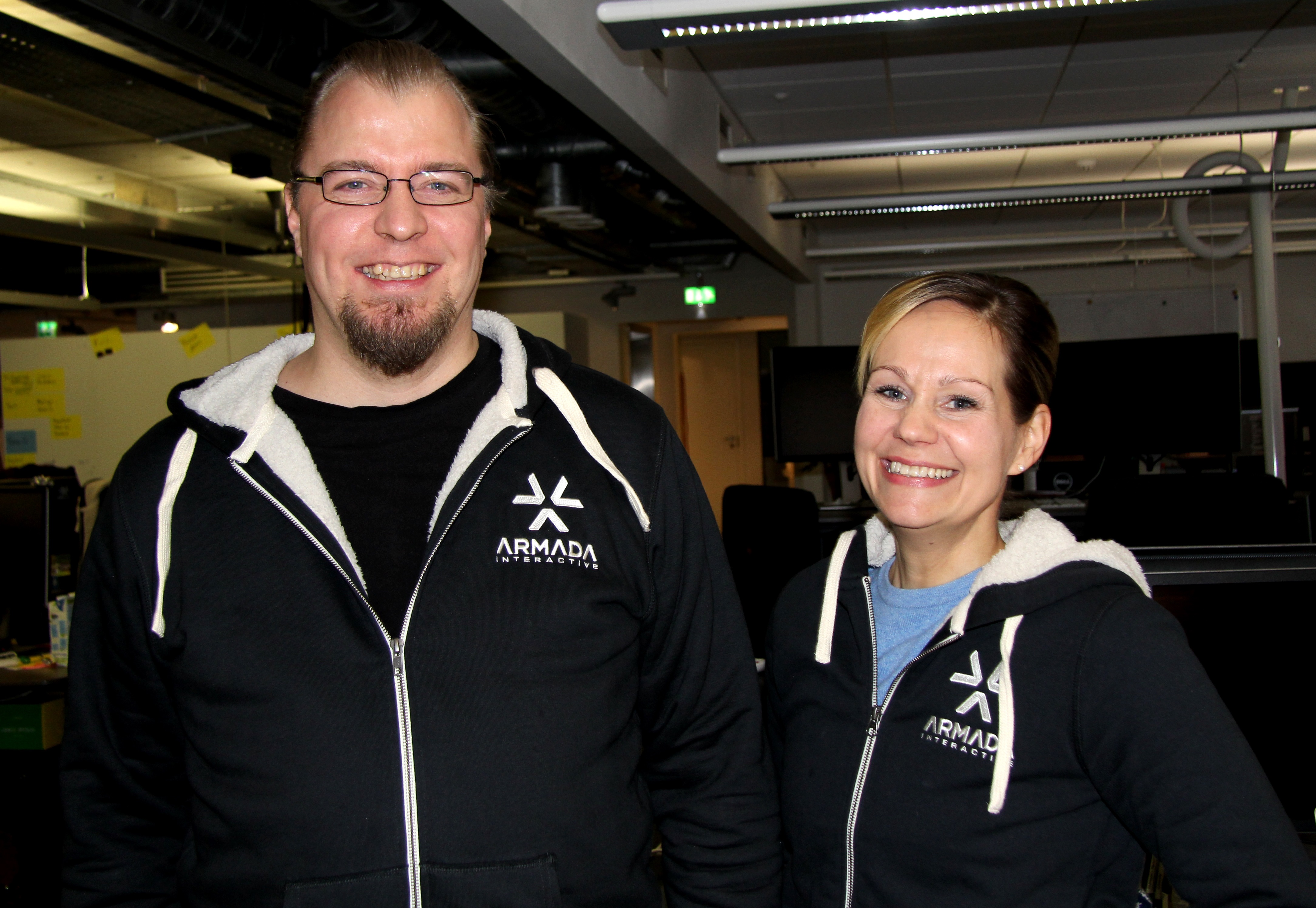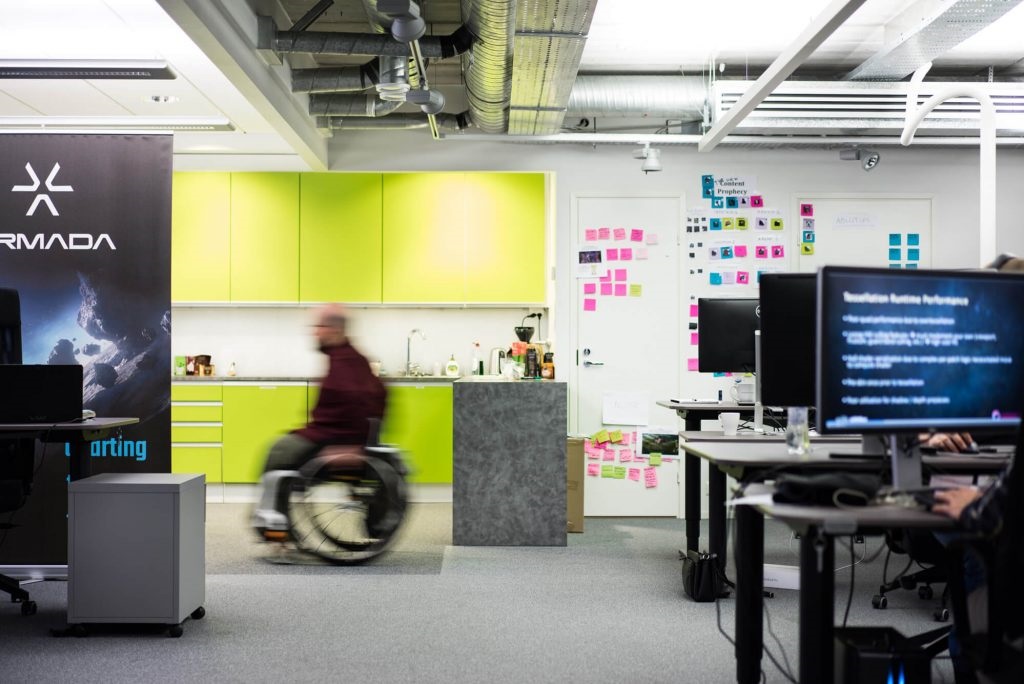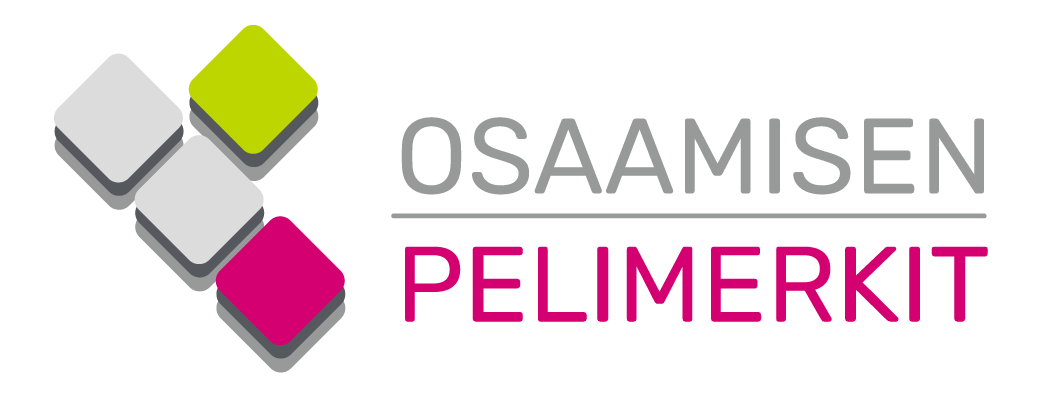
Photo: Minna Kilpeläinen
Game Developer Pekka Hänninen from Armada Interactive has gone a long way into the gaming industry. He graduated as a Bachelor of Media from the Metropolia University of Applied Sciences in spring 2016 after 14 years of shuttle between study and work. All the experience has been beneficial to him, but one of the most significant for his present work was the work-related thesis. Hänninen talks about the relationship between school and working life with his supervisor, Ansu Lönnberg.
“I started communication studies in 2002 in Laurea University of Applied Sciences. Then I hit some bumps in the road, and interrupted my studies for a while. When I returned, that old school didn´ t exist anymore”, Hänninen says.
Hänninen applied again, this time to study digital communication in Metropolia University of Applied Sciences. However, Hänninen was too busy to sit full time on the school bench. “From there I sneaked out to work every now and then. For some time I worked also as a freelancer.”
Hänninen, who was originally aiming to develop his web design expertise, discovered that the game studies was more interesting to him.
“I took to all the game courses with the teacher Juha Huhtakallio that were available back then: two design courses and one big project course.”
At the same time Hänninen was working at Sulake.
“Then when I noticed that I have only 7 months study time left, I wondered if I should make the thesis. Eventually, I put it all together and made a thesis about different reward mechanics in free-to-play games. Partly because of the thesis, I ended up working here in Armada”, Hänninen says.
Armada wasn´ t currently hiring anyone but Hänninen decided to come and have a chat anyway. “When they heard that the case study of my thesis was Clash Royale, they got interested. Then, after the proper job interviews, I got in and I have been working here now for 1,5 years”, Hänninen smiles.
“I could say that the thesis directly lead into getting the job.”
Hänninen himself specializes in balancing. He takes care of developing a smooth and progressive game so that, at some point, someone would also want to pay for it.

Photo: Armada Interactive
Competence counts
“What I can say to everyone who is currently studying and wants to work in the game industry is that do the thesis about the field and do it from your own specialty, because then it works as a very powerful demonstration and evidence of your competence,” Hänninen encourages.
Getting the first job has been difficult in the gaming field for a long time. Most often, the employers want to hire people who have already had at least one job in the field. If there are no junior posts available, one way to get in is to show that you have made at least one published game.
“One way to get your game published is to do it in the school and then really push it to the App Store. So that you really have a game that’s there”, says Hänninen. “Because it’s a terribly big deal for employers to know that you’ve been able to be involved in the process of publishing a product.”
Demos also tell the employer a lot if they are presented well in the portfolio.
“Porfolio is something that you just need to have”, says Armada Interactive’s Head of Studio Ansu Lönnberg. “For example, graphic designers and artists need to have a direct link to a portfolio when they go to talk with the employer.”
Hiring juniors can also give some benefits for game houses.
“Sometimes some of the bigger companies deliberately recruit juniors because they do not have any burdens of history and learned habits”, explains Hänninen. “If they have some brand new way of doing things they want to start using in the long run, then they probably prefer the junior. From five to seven years, he or she will be a senior, who has grown up to the modes of operation they want.”
Finland provides an international work environment for the incomers of the field. Good skills in English language are essential because the working language in the field is English. A great deal of the workforce of Finnish game houses has come from abroad. Less than half of the thirty employees of Armada Interactive are Finnish employees.
“We have here an awesome mix of different nationalities from Chile to Kyrgyzstan. Quite many European countries are represented”, Lönnberg says.
“Foreigners just keep coming to Helsinki”, Hänninen explains. “There´ s practically no question about that Helsinki is the number one place in the mobile game industry in the western countries. London is the second.”
Understanding about entrepreneurship
To get into the field, it is good to have enough understanding about entrepreneurship and self-employment. Hänninen got a good impression about it while working alongside studies. Studies in digital communication also offered entrepreneurship courses from business law to conceptualization.
“We had project courses where we had real customers and we made fragments to their products. Not all of them went into production, but some did”, says Hänninen.
The student teams included a producer, graphic artists, coders, and game designers. Together, teams built functional games.
“It was absolutely incredible. We created a similar team structure that really exists in the game studios. Even though people thought that they were difficult courses, for me they were the most valuable. I learned the realities around which I begun to build my own skills instead of imagining something about the field”, Hänninen says.
Self-made experts at school
At first, the game industry was an arena of self-made experts for a long time.
“When I came to the field almost 20 years ago, the coders and graphic designers were these self-taught ones. There was no game education whatsoever at the time, “Ansu Lönnberg says.
“Even in the company where I was first, the coders had learned the secrets of coding as young boys. Then some studies of Computer Science in the university, and after a year, practically all were recruited somewhere to work”, Lönnberg recalls.
The path begins nowadays at the other end. Earlier you worked and then studied, but now there is another path: through studies to working life. However, Pekka Hänninen does not recommend jumping between school and work. This is because the curriculum changes so often that, after several years’ breaks, the same courses may no longer be accepted for an ongoing degree. However, the perspective you get from work is also beneficial on the school bench.
“Working life shortens the study time if you do it smartly. You will also be more focused on what you want out of school”, says Hänninen.
“And now, when the University of Applied Sciences has the system of accreditation of prior experiental learning, you can contact your teachers and say “Hey, I’ve lead a game team for a year now, so could I get the project management course approved?” And then you write a report about what you have done and where and what responsibilities you had, and you can get your studies pretty much approved”, Hänninen says.

Photo: Armada Interactive
Motivation to self-teaching
Ansu Lönnberg emphasizes the importance of continuous learning even while working.
“If you want to be a game coder, then you have to have the fire and passion to think and study it, even in your own time. There must be a certain level of competence, and there must be a desire to learn more”, Lönnberg emphasizes.
Also a producer and a manager has often come through several routes, but definitely out of love for the field.
“I’m just coincidentally in the gaming industry”, Lönnberg says. “I graduated from Helia from the Business administration and languages program in 2000 and my first job was in Samuli Syvähuoko´ s company, as is this.”
Lönnberg was in her first job around 7 years, during which time she got promoted step by step from an office assistant to a Head of Studio. There were no game schools at the time, and Lönnberg doubts whether she would have applied to them twenty years ago anyway. She learned the skills that she needed at work. “I studied everything that was possible inside the company. I always moved from one place to another and I also had good people around who taught me.”
Hänninen also admits that helping others will get you further.
“I have noticed that teaching things is the best way to learn, because at that point you will have to verbalize all your internal processes and all the silent information that you want to give forward. You rarely think about the reasons why you do some gut-feeling decisions before someone wants to hear the arguments”, says Hänninen.
“Designers do have to justify their decisions, because they have to explain their plans in specific detail for the coders. If there is room for interpretation then it will be interpreted. Or some people refuse to interpret and they will come back to ask, but most of the coders make the interpretation. Just to move forward. If you have explained your plans badly and the coder interprets the guidelines differently, then yes, it is the designer’s fault.”
“The reasons behind that plan will only brighten up when you teach them to someone”, Hänninen sums up.
Good enough, for the progress
In working life, a game artist learns to evaluate when the job is ready for the customer’s needs. During the studies, the artist often makes art for himself and aims to a perfectly finalized work.
“Although it sounds a little harsh, one of the most important skills of a game artist, alongside the actual drawing, painting or 3D skills, is to understand what is good enough and to stop there. Resources are always tight and there is always a hurry, so if the search for perfection either slows down or delays it too much, it does not work”, says Hänninen. “You have to deliver good enough, not perfect, to keep things going.”
“If only a small part of the game was ready and the rest would wait with only placeholders, then it would not work,” Lönnberg explains. “You rather do it in increments and test and see if it works than do it completely and then see if it will work. Make it to some level and give it to test players who give feedback. Then you know whether it is worthwhile to continue with the game.”
“When everything is finished, then, if there is time, we can start making a new round and polish it more”, Hänninen continues.
According to Hänninen, working life processes can very well be learnt in school work life projects and client projects. All students in different roles have the opportunity to test their ability to play their part in the whole process.

Photo: Armada Interactive
Working like gentlemen
You might think that the fierce competition in the gaming industry would also mean harsh manners in the business. Ansu Lönnberg, who has been in the field for 20 years, has a different view.
“I’ve stayed in the gaming industry because this is just an incredible field in Finland. In the beginning everyone knew each other. And people in this field still care about each other, even those in other companies. If someone is having hard times, they are always looked after”, Lönnberg says.
“Of course it’s easy now, when the business is going strong. There are more people looking for professionals than there are competent people. But people still behave like gentlemen, as for example, they don´ t steal the best people out of some smaller firms. We prefer making sure that Finland has a good gaming industry where it is good to do business. And there is more cooperation than competition”, Lönnberg says.
But how about the times when it doesn´ t go so well?
“There are always tough times when small businesses are involved. And when it comes to such a field where, however, some luck is needed, then it is not always a matter of expertise. But in this area, it is not like you hire lots of people when it goes well and then fire them later. You use your common sense”, Lönnberg says.
“Yes, of course, there are ups and downs. When somebody gets a big project, like a licensed game, then you need lots of people to do it. And it may be that when it’s over, then you do not know about the employment situation.”
However, there are no job terminations if a lot of external freelancers are involved.
“In fact, many great artists, the top-of-the-line artists, do not even agree to permanent contracts because they don´ t want to get stuck in one place”, Hänninen explains.
Complicated job interviews
When hiring people the companies don´ t often make their decisions by only interviews and portfolios. In job interview situations the applicants often have to do some practical exercises, too.
“It tests the resistance to pressure. You can be told that hey, here are some pieces of paper, go and design us a game”, says Hänninen.
When Ansu Lönnberg applied to the previous company, she had to put the game developer’s boots on.
“In the third interview, the interviewer just told me that “go to that room and come out with a game”. And six people sat there and stared at me. Then you just had to start by asking them who they were, and then they introduced themselves like “I’m a graphic designer and I’m a coder”. I told them that “here´s our task, we should come up with a game for this brand”. And that’s where we had to start with that team. There was one hour time to do that.”
“There wasn´ t actually a single coder there, but they claimed to be. It was more like, they wanted to test if the team wanted to work with me. At the end of the day, the result was not so important, but how the team experienced me and my skills”, Lönnberg explains.
“And it was really fun, and this method has always been used since then. I have also been involved in those kind of interviews. It’s a really good simulation”, Lönnberg says.
Worker and manager are good together
When Hänninen and Lönnberg are asked to tell each other’s good sides face-to-face, you don´ t have to wait for the comments.
“Ansu is awesome because she takes care of our team. Especially when deadlines are coming, it’s so easy to start staring at those deadlines. People are working longer hours, and feelings get tensed when there is a little more pressure. And then Ansu goes around and asks people that how are you, is everything ok”, says Hänninen.
“But so does Pekka”, Lönnberg says. “And that’s what I really appreciate about you, that you don´ t just work here, but also look after the whole team,” Lönnberg praises Hänninen looking into his eyes.
“And sometimes depending on the situation you need more of those kind of people. But what’s great in Pekka is that he knows exactly where he´s good at and he does it well, but he always says very clearly if there is something he doesn´ t have time to do or can not do for some reason. Then I know immediately that now Pekka needs help. He knows exactly what he is doing and takes care of his own stuff”, says Lönnberg.
“But we only hire the best!” Lönnberg reminds.
Writer: Minna Kilpeläinen, MPhil, MEd, communication specialist, freelance journalist
